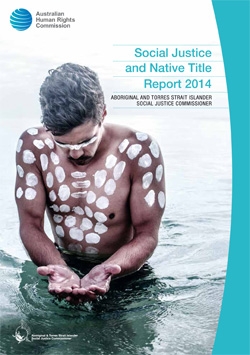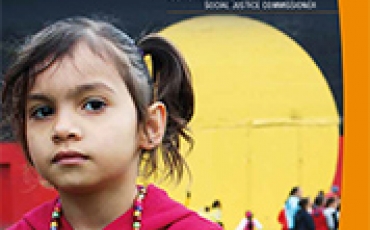Social Justice and Native Title Report 2014
Archived
You are in an archived section of the website. This information may not be current.
This page was first created in November, 2014

Executive Summary
It is with great pleasure that I present my fifth Social Justice and Native Title Report 2014 (the Report) as the Aboriginal and Torres Strait Islander Social Justice Commissioner.
One of my primary responsibilities is to report annually on the enjoyment and exercise of human rights by Aboriginal and Torres Strait Islander peoples.[1] I also report annually on the operation of the Native Title Act 1993 (Cth) (the Native Title Act) and the effect of the Act on the exercise and enjoyment of human rights of Aboriginal and Torres Strait Islander peoples.[2] In 2014, I have again combined the reporting requirements into the Social Justice and Native Title Report, which covers the period from 1 July 2013 to 30 June 2014.
Chapter 1: Social justice - Year in review
In this chapter, I provide a snapshot of the key issues and developments relating to Aboriginal and Torres Strait Islander peoples and their enjoyment and exercise of human rights.
Discussion includes:
- machinery of Government changes
- the 2014 Budget
- leadership, representation and engagement
- recognition of Australia’s First Peoples in the Constitution
- Indigenous Jobs and Training Review
- Closing the Gap.
I am concerned about the lack of clarity in relation to some of these key issues and the impact of this uncertainty on our peoples.
I also report on other developments during the year, including:
- the Collard Stolen Generations test case in Western Australia
- international developments
- complaints received by the Australian Human Rights Commission from Aboriginal and Torres Strait Islander peoples during this reporting period.
Chapter 2: Racial Discrimination Act - Proposed changes to racial hatred provisions
In this chapter, I explore the proposed changes to the racial vilification provisions in sections 18C and 18D of the Racial Discrimination Act 1975 (Cth) (the RDA). I discuss the operation of the RDA in its current form and the reasons for retaining its effective protections for Aboriginal and Torres Strait Islander peoples. I outline principles to guide any future amendments.
Beyond legal protections, I also highlight the role that education and awareness can play in addressing racism.
Chapter 3: Native title - Year in review
In this chapter, I provide an overview of the significant issues that have arisen in native title. I consider the impact of these events on the exercise and enjoyment of our human rights as Aboriginal and Torres Strait Islander peoples.
There are a number of reviews currently underway into the operation of the native title system. These include:
- the Australian Law Reform Commission’s Inquiry into Commonwealth native title laws and legal frameworks[3]
- the review of the roles and functions of Native Title Organisations by Deloitte Access Economics[4]
- the review by the Taxation of Native Title and Traditional Owner Benefits and Governance Working Group of existing arrangements for holding, managing and distributing land-related payments, and to identify options to strengthen governance and promote sustainability [5]
- the review of Indigenous Land Corporation and Indigenous Business Australia by Ernst & Young.[6]
These reviews provide the opportunity to look at the functioning of the system, and to consider necessary changes which will deliver better outcomes for Aboriginal and Torres Strait Islander peoples. It is my hope that once these changes are identified, ways to implement them will be forthcoming.
I also note some concerning native title developments in Queensland and a positive legal outcome in South Australia.
Chapter 4: Creating safe communities
The overrepresentation of Aboriginal and Torres Strait Islander peoples as both victims and offenders in the criminal justice system is one of the most urgent human rights issues facing Australia.
Chapter 4 reflects on the statistics of rates of imprisonment, and highlights the need to create safer communities to address this overrepresentation as both victims and offenders.
I showcase a number of developments towards justice reinvestment in Australia, including ground-breaking community initiatives in Bourke and Cowra, and highlight some of the challenges for implementing justice reinvestment based on the Australian context and international experience.
This chapter reports on the development of the National Justice Coalition and its priorities. Just as the Close the Gap Campaign for health equality has gained broad-based support and government action, I am optimistic that the National Justice Coalition can be a similar circuit breaker in advocating for safer communities.
Chapter 5: Nations - Self-determination and a new era of Indigenous governance
Since the beginning of my term as Aboriginal and Torres Strait Islander Social Justice Commissioner, I have raised the need for stronger and deeper relationships. The United Nations Declaration on the Rights of Indigenous Peoples[7] (the Declaration) can be used to improve relationships between Aboriginal and Torres Strait Islander peoples, the broader community and governments.[8] I highlight the need for leadership in building and supporting effective Indigenous governance, and set out a framework for approaching this issue.[9]
In this chapter, I discuss Nations and ‘Nation building’ – that is, enhancing the capacities of Indigenous nations for self-governance and self-determined economic development. I present research which shows that where local Aboriginal and Torres Strait Islander nations, communities, authorities and organisations have power and control over decision making and resources, real change is achieved in a more sustainable way.
My view is that Nation building guided by the Declaration will lead to the realisation of Aboriginal and Torres Strait Islander rights, stronger communities and more meaningful engagement.
Chapter 6: Giving effect to the Declaration
This chapter sets out a path for advancing the implementation of the Declaration within Australia, and the benefits that will result from this.
It reflects on the Declaration Dialogues that have been held by the Australian Human Rights Commission and the National Congress of Australia’s First Peoples in Aboriginal and Torres Strait Islander communities across the country over the past year.[10]
This chapter also highlights the need for improved engagement and concrete action to embed the Declaration in activities by all sectors of society: by governments, civil society, the private sector, and by Aboriginal and Torres Strait Islander communities.
Recommendations
Recommendation 1: The Australian Government revises its current position on targets as part of Closing the Gap, to include holistic justice targets aimed at promoting safer communities.
Recommendation 2: The Australian Government actively consults and works with the National Justice Coalition on justice related issues.
Recommendation 3: The Australian Government takes a leadership role on justice reinvestment and works with states, territories and Aboriginal and Torres Strait Islander communities to identify further trial sites.
Recommendation 4: The Australian Government:
- acknowledges that effective local community governance is central to achieving sustainable development in Aboriginal and Torres Strait Islander communities
- acknowledges the Nation building efforts to date and engages with those Nations as a means of linking with local Aboriginal and Torres Strait Islander peoples
- continues to resource and support research into the concept of nationhood, such as the Indigenous Nation Building Collaboration.
Recommendation 5: The Australian Government agrees to engage with the National Implementation Strategy to give effect to the United Nations Declaration on the Rights of Indigenous Peoples.
Recommendation 6: The Australian Government amends the Human Rights (Parliamentary Scrutiny) Act 2011 (Cth) to include the United Nations Declaration on the Rights of Indigenous Peoples in the definition of human rights.
[1] Australian Human Rights Commission Act 1986 (Cth), s 46C(1)(a).
[2] See s 209 of the Native Title Act 1993 (Cth).
[3] Australian Law Reform Commission, Review of the Native Title Act 1993 (IP 45). At http://www.alrc.gov.au/publications/native-title-ip-45 (viewed 8 October 2014).
[4] Deloitte Access Economics, Review of roles and functions of Native Title Organisations. At http://www.deloitteaccesseconomics.com.au/our+services/economic+analysis+and+policy/native+title/about+the+review (viewed 8 October 2014).
[5] Commonwealth of Australia, Taxation of Native Title and Traditional Owner Benefits and Governance Working Group. At http://www.treasury.gov.au/PublicationsAndMedia/Publications/2013/Taxation-of-Native-Title (viewed 8 October 2014).
[6] Ernst & Young, Review of the Indigenous Land Corporation and Indigenous Business Australia (2014). At http://www.dpmc.gov.au/publications/docs/EY_final_report_review_of_ILC_IBA.PDF (viewed 8 October 2014).
[7] United Nations Declaration on the Rights of Indigenous Peoples, GA Resolution 61/295, UN Doc A/61/L.67 (2007).
[8] M Gooda, Social Justice Report 2011, Australian Human Rights Commission (2011), p 106. At https://www.humanrights.gov.au/publications/social-justice-report-2011
(viewed 8 October 2014).
[9] M Gooda, Social Justice Report 2012, Australian Human Rights Commission (2012), ch 2. At https://www.humanrights.gov.au/publications/social-justice-report-2012 (viewed 8 October 2014).
[10] For an overview of this see: Australian Human Rights Commission 2013, Implementation of the United Nations Declaration on the Rights of Indigenous Peoples – Declaration Dialogue Series:Discussion Paper 1 - Giving Full Effect to the Declaration – A National Strategy (July 2013) p 8. At: http://www.humanrights.gov.au/publications/declaration-dialogue-series (viewed 22 August 2014).



